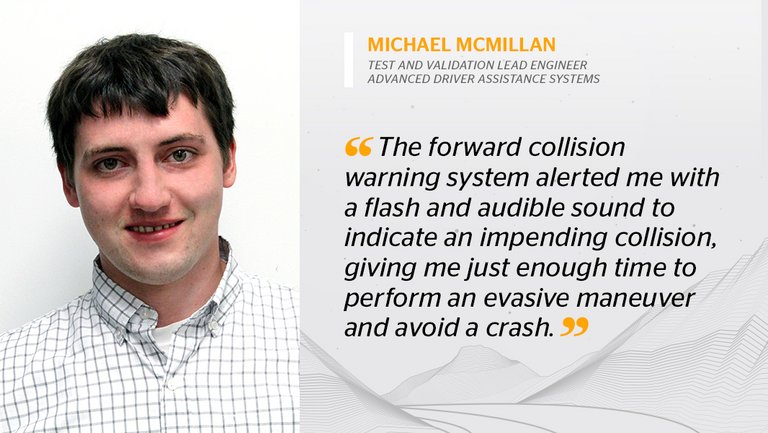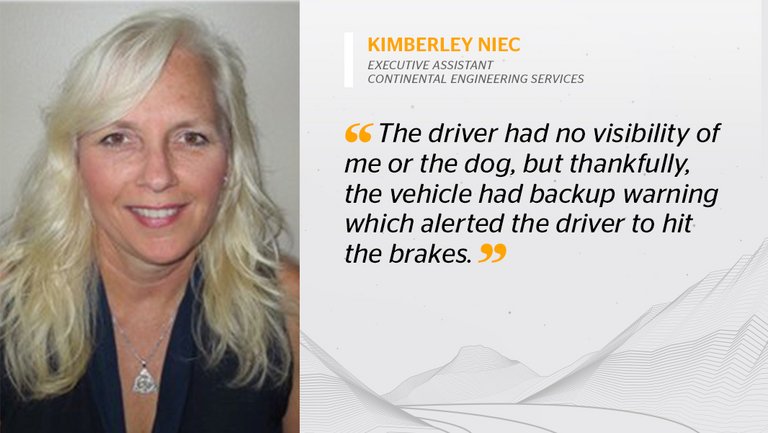#SafelyThere Stories
As part of our campaign, we are collecting safety awareness stories. We hope that these personal narratives inspire you to share a time when automotive technology potentially saved your life, or the life of someone you love; or simply help you gain a better understanding of the technology's many benefits.
We all know what a busy day in a grocery store parking lot can look like. Cars backing out and pulling in. Pedestrians coming and going. Carts everywhere. That’s the scene Sandra Soliman, Sales Analyst with Continental’s Surface Solutions team, encountered one afternoon while shopping with her family.
Sandra completed her shopping and packed her kids and groceries into the car to head home. As Sandra was backing out of her parking space, trying to see around the two trucks parked on either side of her sedan, an alert in her vehicle went off prompting her to quickly hit the brakes. The sound was her Rear Cross-Traffic Alert calling attention to a rapidly approaching vehicle outside of her sight line.
Luckily, the alert and notification caught my attention and I was able to brake in time to avoid a potential accident.
“I was especially shaken because my kids were in the car with me. The sensors really helped and saved us,” Sandra remembered.
According to NHTSA and the Department of Transportation (DOT), backover crashes average 210 fatalities and 15,000 injuries annually.
“I’m just thankful for the technology that saved my family and I that day,” Sandra said.
Hagan Hill’s job as a territory manager for Continental’s Industrial business area means that no two days are the same.
“A big part of my job is working with our customers in a hands-on way,” Hagan explains. “Sometimes, that takes me to a manufacturing facility to better understand a challenge being experienced with a conveyor belt, other times I find myself going down into a mine to ensure our products are working as designed.”
Recently, Hagan found himself onsite with a customer at a rock quarry, a type of open-pit mine in which certain types of rock are excavated from the ground, when advanced safety technology in his vehicle helped him avoid a collision.
“I was backing up to leave the quarry and a piece of equipment had been moved blocking my path forward,” Hagan remembers.
My backup camera was covered in dust making it impossible to see, however my mirrors were clean and I checked them.
Hagan began to reverse after he confirmed in his mirrors there was nothing behind him, when his vehicle began beeping and automatically stopped his SUV. When Hagan checked his mirrors again, he saw someone standing behind his vehicle. There was a worker kneeling behind the SUV tying his boots and was not visible in the vehicle’s mirrors and could not be seen in the backup camera due to all the dust.
According to a report from the National Highway Traffic Safety Administration (NHTSA), backover crashes are estimated to cause between 6,700 and 7,419 injuries per year.
“When my backup collision avoidance system kicked in and stopped the vehicle, I made eye contact with the worker in my mirror and we both nodded, then he walked away,” Hagan recalls. “Thank God for that safety feature, my vehicle stopped and prevented a crash and potential injury!”
Michael McMillan is a Test and Validation Lead Engineer, Advanced Driver Assistance Systems, based in Auburn Hills, Michigan. This is his #SafelyThere story.
On a Friday after Thanksgiving Day, one of the busiest shopping days of the year in the United States, Michael was driving his family to a store, when, in a split-second, they experienced the value of advanced safety technology.
“While I was looking over my shoulder to check if the adjacent lane was clear to change lanes, the driver in the vehicle ahead of me hit his brakes," Michael shared.
The forward collision warning system alerted me with a flash and audible sound to indicate an impending collision, giving me just enough time to perform an evasive maneuver and avoid a crash.
According to a study by the Insurance Institute for Highway Safety (IIHS), systems with forward collision warning reduce rear-end crashes by about 23 percent on average.
“Everyone in the car was shocked at how well the system worked. We all agreed this safety technology was essential in preventing a collision and keeping us safe,” Michael said.
Jeff Skvarce, Crash and Regulatory Research Manager, spends most of his time paying close attention to trends, policies and research that impact vehicle safety.
“My job is to follow trends and apply research to topics like intersections, head on-collisions, pedestrian crashes and more to support project teams working on mobility solutions,” Jeff explained. “To bolster the efforts of getting safety technologies into more vehicles, I also help educate lawmakers and regulators about potentially lifesaving vehicle technologies by engaging in research with universities, and supporting various conferences and safety groups. I then digest this information and ensure my Continental colleagues are informed on what I learn.”
Shortly after joining Continental in 1992, Jeff began working on brake systems and supported the rollout of electronic stability control (ESC). As Jeff worked on ESC, he really came to understand its lifesaving potential. In fact, a study done by the National Highway Traffic Safety Association (NHTSA) shows that the risk of a fatal passenger-vehicle rollover is reduced by 72 percent with the addition of ESC.
In parallel, Jeff began to understand the influence Continental and other companies in the automotive safety industry could have on government regulations of safety technology through education.
“I began working with the National Highway Transportation Safety Association (NHTSA) to provide test and simulation data to educate regulators on the benefits of ESC, and support development of an ESC Federal Motor Vehicle Safety Standard,” Jeff recalled. “We also educated safety advocate groups like the Insurance Institute for Highway Safety and Consumer Reports on the benefits of ESC technology.”
From Education to Impact
Continental, convinced of the lifesaving potential of ESC, launched consumer education campaigns, largescale advertisements and even a traveling ESC educational roadshow to bring awareness to the technology and help people understand how it works. As of 2012, ESC is mandatory on all new vehicles – likely saving countless lives. Something that motivates Jeff each and every day.
“My uncle was killed as a teenager following a road departure before I met him, my niece was seriously injured riding a tri-cycle in her neighborhood and I witnessed the aftermath of a highway crash where a parent was holding their kid on the highway amongst the wreckage,” Jeff remembered.
All of these crashes may have been avoided with the technology available today – technology we are working on at Continental.
Jeff’s research helps to identify specific crash types, like those that take place around intersections or those caused by wrong-way drivers, which helps engineers working on advanced driver assistance systems (ADAS) determine if new solutions can be developed. He often thinks of his personal experiences when he is researching trends and is motivated to work with colleagues to engineer technologies that can help prevent or mitigate crashes.
“It's interesting that our government intentionally avoids using the word ‘accident’ to describe a vehicle collision because ‘accidents,’ by definition, are not avoidable. Instead they, identify ALL of them as ‘crashes’ that are avoidable with the right education and ADAS technology,” Jeff said.
The ADAS technologies that Jeff’s research helps to shape continue to become more widely available to car buyers.
“ADAS functions are ready and available today on most vehicles,” Jeff said. “As these ADAS features get into more vehicles, the general driving public will become more aware of these building-block technologies and their lifesaving potential. We believe that widespread adoption of these features will help us inch closer to Vison Zero: zero traffic fatalities, injuries and, ultimately, crashes.”
Travis Smith is a Senior Simulation Engineer, based in Auburn Hills, Michigan. This is his #SafelyThere story.
What started as a normal spring afternoon could have ended much worse. As I backed out of my driveway to run an errand, I was surprised when my vehicle began to beep and abruptly stopped. My heart raced as I realized what had happened – I was looking one way and a neighborhood kid had sped across my driveway on his bike from the other direction.
I am grateful that my automatic emergency braking (AEB) kicked in just a second earlier than my own reaction – that one second could have changed everything.
The boy was able to continue his joyride, and hopefully he will be more aware the next time he is crossing a vehicle’s path.
Living in a suburban neighborhood, I am used to children playing outside in warm weather and I strive to remain aware of my surroundings. However, despite our best intentions, our awareness can be flawed. This experience reinforced my belief that advanced driver assistance systems do not replace the driver, but instead they assist when our own reflexes are not quick enough.
According to IIHS, backover crashes account for approximately 15,000 injuries annually – meaning that stories like mine are very common. I am grateful that my vehicle has a backup camera and AEB, because I know that without it my near-crash would have contributed to this statistic.
Rahul Gujar is a Software Engineer for Corporate Quality and Environment, North America, based in Auburn Hills, Michigan. This is his #SafelyThere story.
I was driving home from work on a hot August day, and I began to merge from one highway to another during peak traffic. The M-59 and I-75 interchange in Michigan is notoriously busy during rush hour – the cloverleaf design is intended to alleviate congestion, but it can also be difficult to navigate.
As I turned my blinker on and began to merge right, my blind spot detection system began to beep. I was confident that I hadn’t seen a car in the lane next to me, but due to the alert I looked again. A car was coming quickly from behind and was extremely close to my vehicle. The alert gave me just enough time to slow my car nearly to a stop, letting the other car continue to merge onto I-75.
If installed on all vehicles, blind spot warning technology could potentially prevent 318,000 crashes a year, according to the AAA Foundation. I experienced a close call, but the warning gave me the moment I needed to react before a crash occurred.
Arnie Levitan works for Supplier Quality Management, Cluster Electronics, North America, based in Deer Park, Illinois. This is his #SafelyThere story.
A few years back, my family and I took a quick trip to see a Bears game and as we were driving home, a sudden hard rain began. The car in front of us began to drift into another lane – where a semi-truck was also pressing through the weather.
Their light collision triggered a jack knife reaction from the truck’s trailer. Everything seemed to move in slow motion. I began to hit my brakes and, with the assistance of anti-lock braking, I was able to make a smooth stop on the shoulder. The vehicle behind me pulled over as well, unfortunately landing in the ditch to avoid another collision.
After stopping safely, I was able to call 911 and check on the victims of the crash. We helped to direct traffic until the emergency responders arrived and took over. I am overwhelmingly grateful for my anti-lock braking system and proud that the company I work for helped to develop this technology.
According to NHTSA, in 2017 there were 4,761 people killed in crashes involving large trucks – a 9% increase from 2016. In fair conditions, fully loaded trucks can take over 500 feet to come to a complete stop. This experience enforced the importance of keeping a safe following distance when behind trucks, especially in bad weather. And, when the unexpected happens, I’m grateful for the vehicle technologies that keep me – and those around me – safe on the road.
Renu Aggarwal is a Product Development Chemist for ContiTech, based in Winchester, Virginia. This is her #SafelyThere story.
My long-time friend and I were driving to Lancaster, Pennsylvania, for a much-needed weekend of fun. After a long day in the car, it started to get dark outside and I could tell that something was different in the way my friend was driving. We started to weave, ever so slightly, in our lane. The lane departure warning would alert us every few minutes and I carefully offered to drive. My friend did not want to switch drivers.
She suffers from sleep apnea, which inhibits her from sleeping soundly through the night. This condition puts her more at risk for falling asleep in other situations, like at work or behind the wheel. It is hard to tell somebody to pull over and even more difficult because she did not realize that her medical condition was impairing her driving.
When the alert started going off more frequently, she finally decided it was time to pull over and switch. A few hours later, we arrived #SafelyThere. It was an amazing trip, eating local food and visiting the Speedwell Wolves sanctuary.
I think most of us believe that our driving is safe, even when we are overtired or distracted. It is a difficult choice to pull over and take a nap, switch drivers, or respond to a text when the vehicle is no longer in motion. According to NHTSA, every year there are 100,000 crashes due to drowsy driving. I am grateful for the technologies that can alert drivers to risky behavior, but I will also do my part to choose not to get behind the wheel when I’m feeling anything less than attentive.
Kimberley Niec is an Executive Assistant for Continental Engineering Services, North America, based in Auburn Hills, Michigan. This is her #SafelyThere story.
My husband and I were visiting our friends in Austin, Texas and, as we were on our way to get lunch one day, my friend and I noticed a little white cockapoo running loose through the neighborhood. We could see that he was wearing a collar with tags, so he likely had a home nearby. We pulled our car over and jumped out to try to catch him.
When we started to chase the dog, he thought that we were playing and ran off in a different direction. I was bent over chasing the dog across a driveway as a vehicle was backing out of the garage. The driver had no visibility of me or the dog, but thankfully, the vehicle had a backup camera and warning which alerted the driver to hit the brakes.
According to an IIHS study, it can be expected that backup cameras can prevent nearly 1 in 6 backing crashes and we witnessed this statistic in action. The driver was very grateful that we were safe and happy to help assist with the catch. We finally got hold of the dog, who we learned was named Biscuit, and returned him to his home. After all the excitement of the chase, I’m glad to report that we reached a happy ending – thanks to advanced driver assistance technology!









